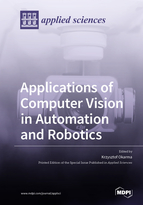Applications of Computer Vision in Automation and Robotics
A special issue of Applied Sciences (ISSN 2076-3417). This special issue belongs to the section "Computing and Artificial Intelligence".
Deadline for manuscript submissions: closed (31 July 2020) | Viewed by 40720
Special Issue Editor
Interests: applied computer science; particularly image processing and analysis; computer vision and machine vision in automation and robotics; image quality assessment; video and signal processing applications in intelligent transportation systems
Special Issues, Collections and Topics in MDPI journals
Special Issue Information
Dear Colleagues,
Computer vision applications have become one of the most rapidly developing areas in automation and robotics, as well as in some other similar areas of science and technology, e.g., mechatronics, intelligent transport and logistics, biomedical engineering, and even in the food industry. Nevertheless, automation and robotics seems to be one of the leading areas of practical applications for recently developed artificial intelligence solutions, particularly computer and machine vision algorithms. One of the most relevant issues is the safety of the human–computer and human–machine interactions in robotics, which requires the “explainability” of algorithms, often excluding the potential application of some solutions based on deep learning, regardless of their performance in pattern recognition applications.
Considering the limited amount of training data, typical for robotics, important challenges are related to unsupervised learning, as well as no-reference image and video quality assessment methods, which may prevent the use of some distorted video frames for image analysis applied for further control of, e.g., robot motion. The use of image descriptors and features calculated for natural images captured by cameras in robotics, both in “out-hand” and “in-hand” solutions, may cause more problems in comparison to artificial images, typically used for the verification of general-purpose computer vision algorithms, leading to a so-called “reality gap”.
This Special Issue on “Applications of Computer Vision in Automation and Robotics” will bring together the research communities interested in computer and machine vision from various departments and universities, focusing on both automation and robotics as well as computer science.
Topics of interest for this Special Issue include but are not limited to the following:
- Video simultaneous localization and mapping (VSLAM) solutions
- Image-based navigation of unmanned aerial vehicles (UAVs) and other mobile robots
- Texture analysis and shape recognition
- Novel image descriptors useful for image-based classification of objects
- Feature extraction and image registration
- Binarization algorithms and binary image analysis
- Fast algorithms useful for embedded solutions, e.g. based on the Monte Carlo method
- No-reference image quality assessment
- Natural image analysis
- Applications of computer vision in autonomous vehicles.
Dr. Hab. Krzysztof Okarma
Guest Editor
Manuscript Submission Information
Manuscripts should be submitted online at www.mdpi.com by registering and logging in to this website. Once you are registered, click here to go to the submission form. Manuscripts can be submitted until the deadline. All submissions that pass pre-check are peer-reviewed. Accepted papers will be published continuously in the journal (as soon as accepted) and will be listed together on the special issue website. Research articles, review articles as well as short communications are invited. For planned papers, a title and short abstract (about 100 words) can be sent to the Editorial Office for announcement on this website.
Submitted manuscripts should not have been published previously, nor be under consideration for publication elsewhere (except conference proceedings papers). All manuscripts are thoroughly refereed through a single-blind peer-review process. A guide for authors and other relevant information for submission of manuscripts is available on the Instructions for Authors page. Applied Sciences is an international peer-reviewed open access semimonthly journal published by MDPI.
Please visit the Instructions for Authors page before submitting a manuscript. The Article Processing Charge (APC) for publication in this open access journal is 2400 CHF (Swiss Francs). Submitted papers should be well formatted and use good English. Authors may use MDPI's English editing service prior to publication or during author revisions.
Keywords
- Image analysis
- machine vision
- video analysis
- visual inspection and diagnostics
- industrial and robotic vision systems






